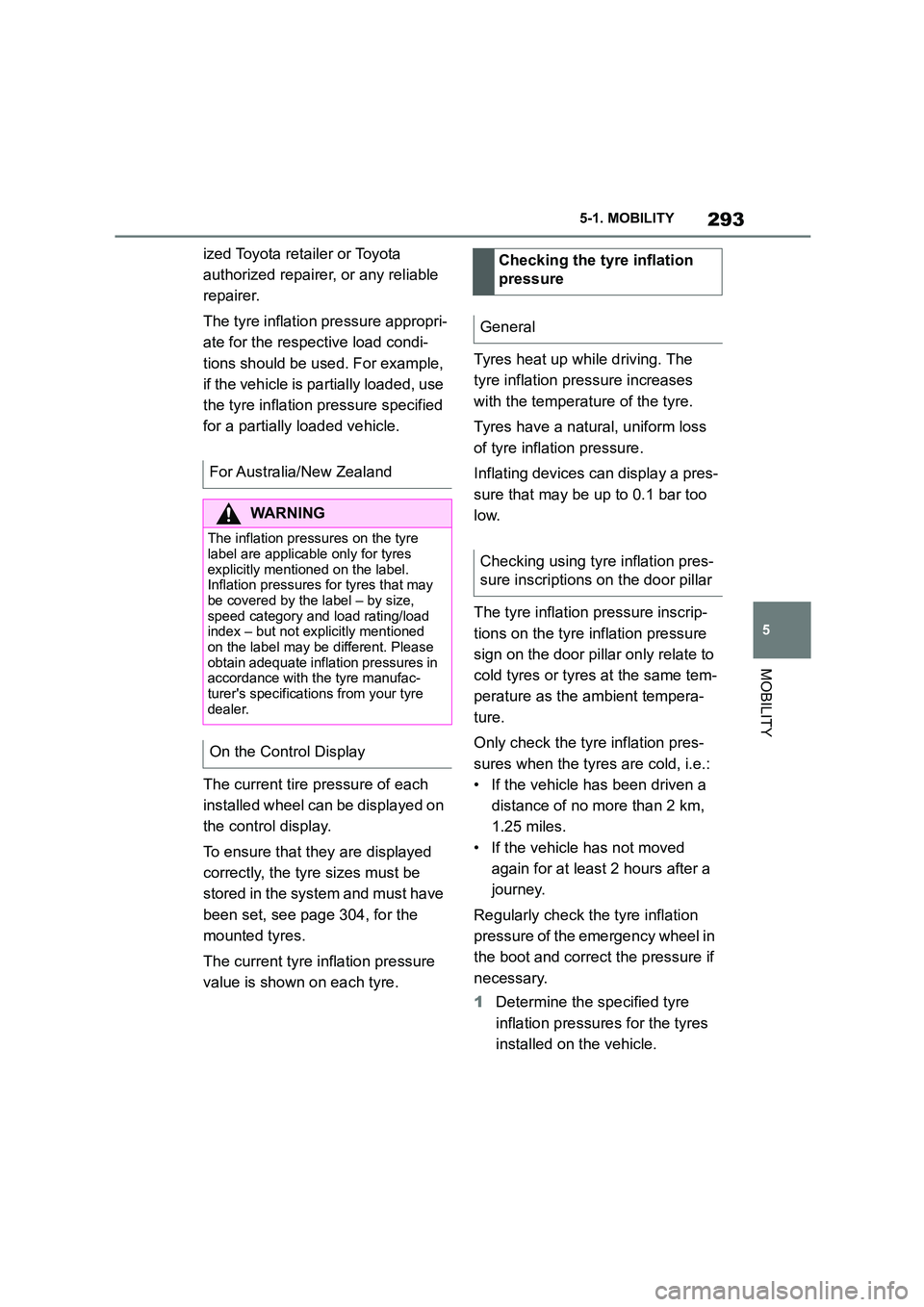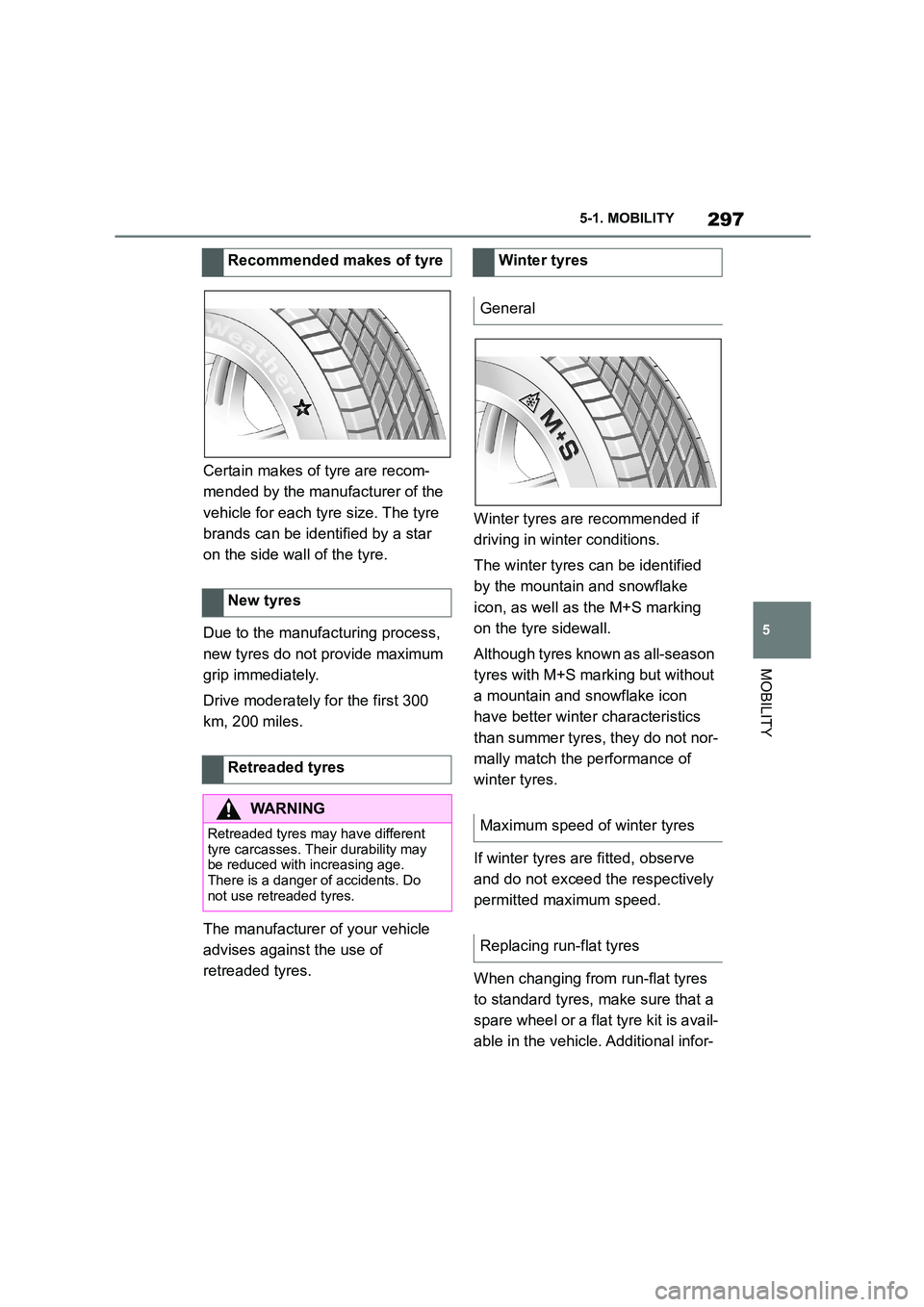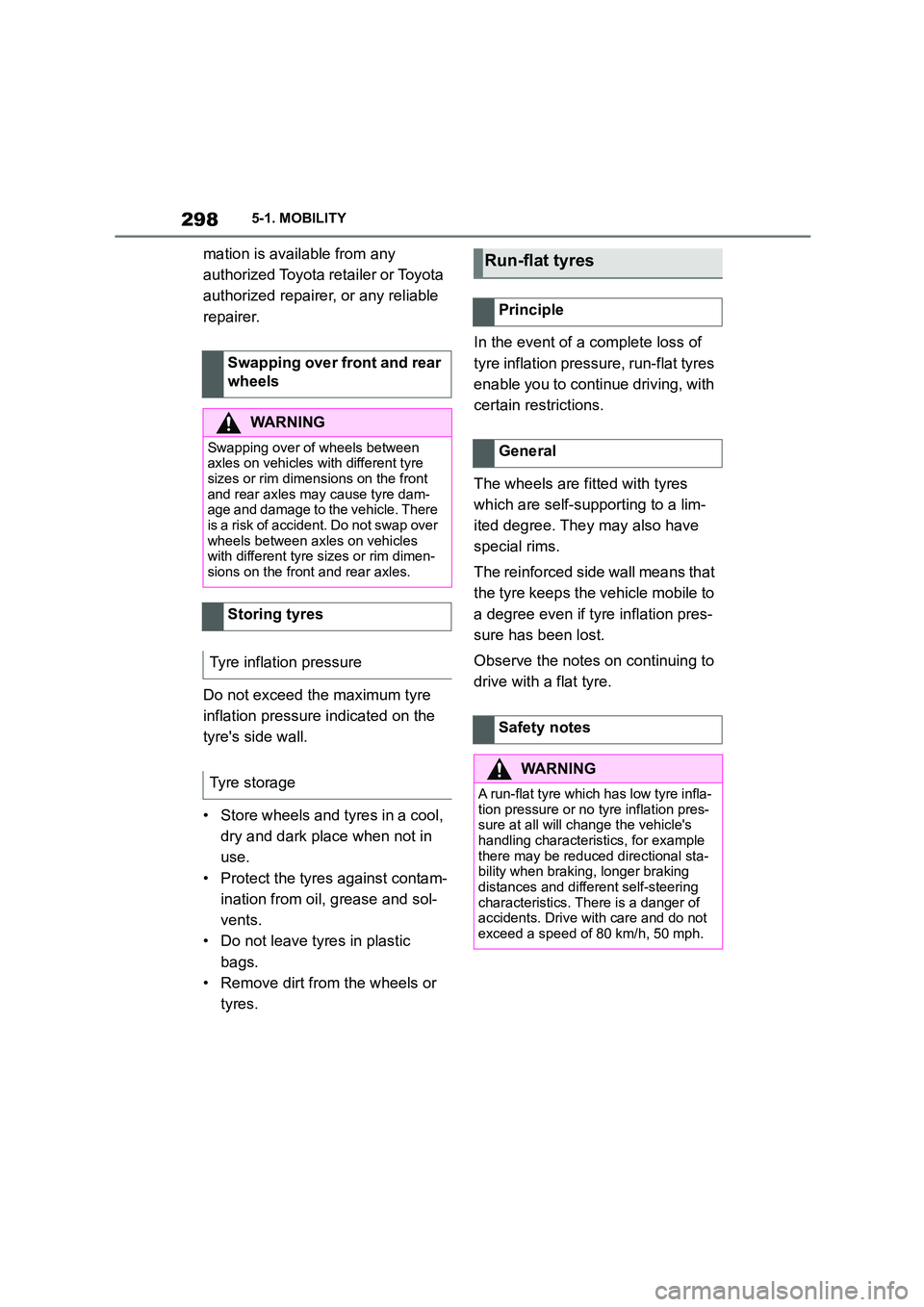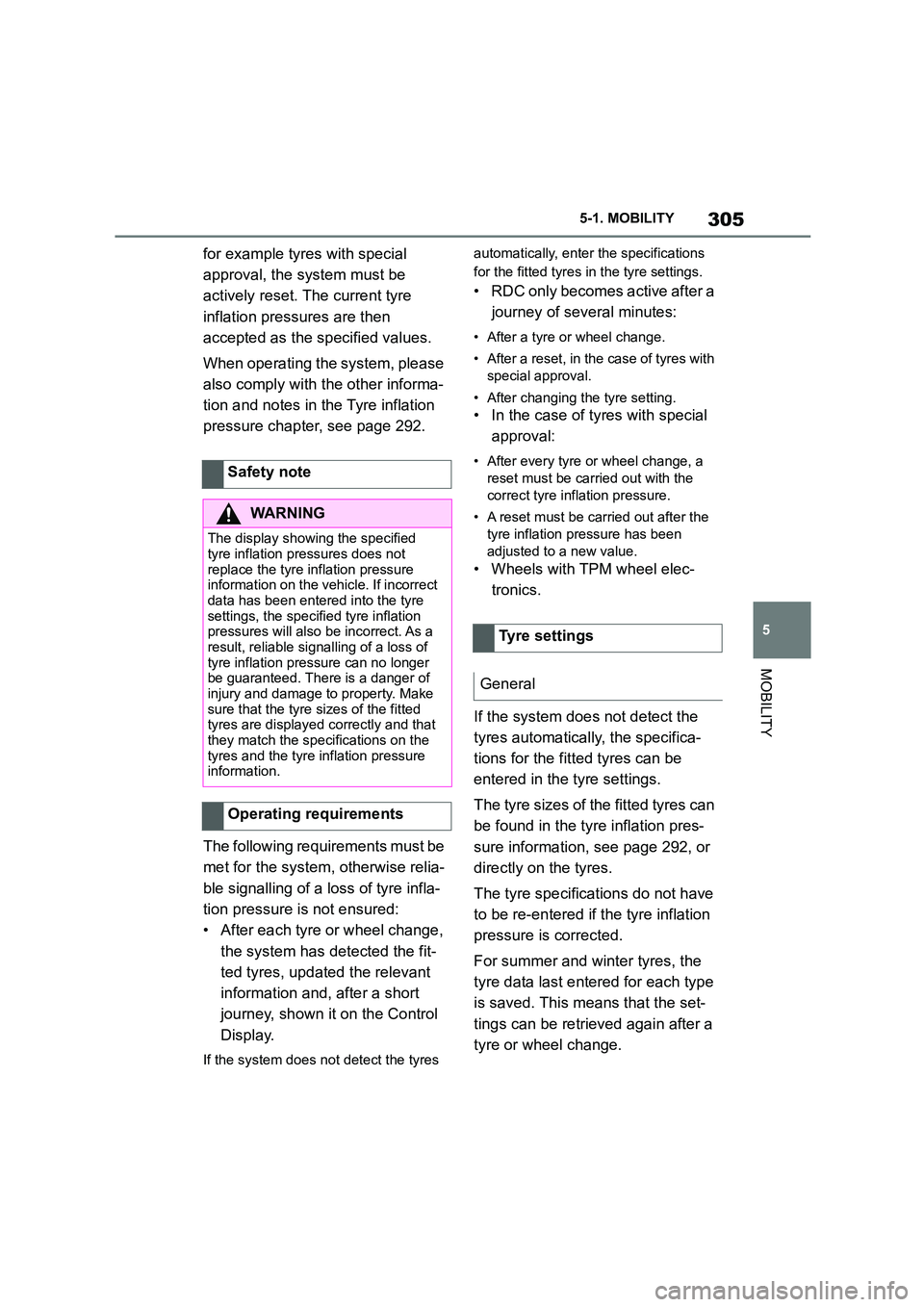2022 TOYOTA SUPRA wheel size
[x] Cancel search: wheel sizePage 294 of 498

2925-1. MOBILITY
This chapter describes all standard,
country-specific and special equip-
ment available for the model series.
It may therefore describe equip-
ment and functions which are not
installed in your vehicle, for exam-
ple on account of the special equip-
ment selected or the country
specification. This also applies to
safety-relevant functions and sys-
tems. Please comply with the rele-
vant laws and regulations when
using the corresponding functions
and systems.
A tyre's condition and inflation pres-
sure influence the following:
• Lifetime of the tyre.
• Driving safety.
• Driving comfort.
• Fuel consumption.
The tyre inflation pressure informa-
tion is located on the body pillar of
the driver's door.
The tyre pressure applies to all tyre
sizes and recommended tyre
makes that have been rated by the
vehicle manufacturer as suitable for
the vehicle type concerned. The list
can also include tyre sizes that are
only suitable in combination with
specific equipment.
Information about approved wheels
and tyres for the vehicle can be
requested from one of any author-
Wheels and tyres
Vehicle equipment
Tyre inflation pressure
General
Safety note
WA R N I N G
A tyre with too little or no tyre inflation
pressure can heat up significantly and sustain damage. Driving properties,
for example steering and braking, will
be impaired as a result. There is a danger of accidents. Check the tyre
inflation pressure regularly and adjust
as necessary, for example twice a
month or before any long journey
Tyre inflation pressure infor-
mation
On the door pillar
Page 295 of 498

293
5
5-1. MOBILITY
MOBILITY
ized Toyota reta iler or Toyota
authorized repairer, or any reliable
repairer.
The tyre inflation pressure appropri-
ate for the respective load condi-
tions should be used. For example,
if the vehicle is partially loaded, use
the tyre inflation pressure specified
for a partially loaded vehicle.
The current tire pr essure of each
installed wheel can be displayed on
the control display.
To ensure that they are displayed
correctly, the tyre sizes must be
stored in the system and must have
been set, see page 304, for the
mounted tyres.
The current tyre inflation pressure
value is shown on each tyre.
Tyres heat up while driving. The
tyre inflation pressure increases
with the temperature of the tyre.
Tyres have a natural, uniform loss
of tyre inflation pressure.
Inflating devices can display a pres-
sure that may be up to 0.1 bar too
low.
The tyre inflation pressure inscrip-
tions on the tyre inflation pressure
sign on the door pillar only relate to
cold tyres or tyres at the same tem-
perature as the ambient tempera-
ture.
Only check the tyre inflation pres-
sures when the tyres are cold, i.e.:
• If the vehicle has been driven a
distance of no more than 2 km,
1.25 miles.
• If the vehicle has not moved
again for at least 2 hours after a
journey.
Regularly check the tyre inflation
pressure of the emergency wheel in
the boot and correct the pressure if
necessary.
1 Determine the specified tyre
inflation pressures for the tyres
installed on the vehicle.
For Australia/New Zealand
WA R N I N G
The inflation pressures on the tyre
label are applicable only for tyres
explicitly mentioned on the label. Inflation pressures for tyres that may
be covered by the label – by size,
speed category and load rating/load index – but not explicitly mentioned
on the label may be different. Please
obtain adequate inflation pressures in accordance with the tyre manufac-
turer's specifications from your tyre
dealer.
On the Control Display
Checking the tyre inflation
pressure
General
Checking using tyre inflation pres-
sure inscriptions on the door pillar
Page 298 of 498

2965-1. MOBILITY
The date of manufacture of the tyre
is indicated on the tyre sidewall.
Have the wheel fitted and balanced
by any authorized Toyota retailer or
Toyota authorized repairer, or any
reliable repairer.
The following properties are recom-
mended and approved by the man-
ufacturer of the vehicle for the
approved wheels and tyres per
vehicle type and special equipment:
• Wheel and tyre combinations.
•Rim designs.
• Tyre sizes.
• Tyre makes.
You can ask any authorized Toyota
retailer or Toyota authorized
repairer, or any reliable repairer
about the approved wheels and
tyres for the vehicle and the special
equipment.
Date of manufacture
DesignationDate of manufac-
ture
DOT … 382038th week of 2020
Replacement of wheels and
tyres
Fitting and balancing
Permissible wheels and tyres
General
Safety notes
WA R N I N G
Wheels and tyres that are not suitable
for your vehicle can damage parts of the vehicle. For example they could
come into contact with the bodywork
on account of their dimensional toler- ances, despite having the same nomi-
nal size. There is a danger of
accidents. The manufacturer of the
vehicle recommends using wheels and tyres that have been categorised
as suitable for the respective vehicle
type.
WA R N I N G
Mounted steel wheels can lead to
technical problems, for example wheel studs may work loose and
brake discs may be damaged. There
is a risk of accident. Do not install steel wheels.
WA R N I N G
Incorrect wheel/tyre combinations
impair the vehicle's handling charac- teristics and interfere with the proper
functioning of various systems, such
as the Anti-lock Brake System or Vehicle Stability Control. There is a
danger of accidents. To maintain good
vehicle handling, always fit tyres of the same make and tread pattern to
all wheels. The manufacturer of the
vehicle recommends using wheels and tyres that have been categorised
as suitable for the respective vehicle
type. After a tyre has been damaged, refit the same wheel/tyre combination
as the original.
Page 299 of 498

297
5
5-1. MOBILITY
MOBILITY
Certain makes of tyre are recom-
mended by the manufacturer of the
vehicle for each tyre size. The tyre
brands can be identified by a star
on the side wall of the tyre.
Due to the manufacturing process,
new tyres do not provide maximum
grip immediately.
Drive moderately for the first 300
km, 200 miles.
The manufacturer of your vehicle
advises against the use of
retreaded tyres.
Winter tyres are recommended if
driving in winter conditions.
The winter tyres can be identified
by the mountain and snowflake
icon, as well as the M+S marking
on the tyre sidewall.
Although tyres known as all-season
tyres with M+S marking but without
a mountain and snowflake icon
have better winter characteristics
than summer tyres, they do not nor-
mally match the performance of
winter tyres.
If winter tyres are fitted, observe
and do not exceed the respectively
permitted maximum speed.
When changing from run-flat tyres
to standard tyres, make sure that a
spare wheel or a flat tyre kit is avail-
able in the vehicle. Additional infor-
Recommended makes of tyre
New tyres
Retreaded tyres
WA R N I N G
Retreaded tyres may have different tyre carcasses. Their durability may
be reduced with increasing age.
There is a danger of accidents. Do not use retreaded tyres.
Winter tyres
General
Maximum speed of winter tyres
Replacing run-flat tyres
Page 300 of 498

2985-1. MOBILITY
mation is available from any
authorized Toyota retailer or Toyota
authorized repairer, or any reliable
repairer.
Do not exceed the maximum tyre
inflation pressure indicated on the
tyre's side wall.
• Store wheels and tyres in a cool,
dry and dark place when not in
use.
• Protect the tyres against contam-
ination from oil, grease and sol-
vents.
• Do not leave tyres in plastic
bags.
• Remove dirt from the wheels or
tyres.
In the event of a complete loss of
tyre inflation pressure, run-flat tyres
enable you to continue driving, with
certain restrictions.
The wheels are fitted with tyres
which are self-supporting to a lim-
ited degree. They may also have
special rims.
The reinforced side wall means that
the tyre keeps the vehicle mobile to
a degree even if tyre inflation pres-
sure has been lost.
Observe the notes on continuing to
drive with a flat tyre.
Swapping over front and rear
wheels
WA R N I N G
Swapping over of wheels between
axles on vehicles with different tyre
sizes or rim dimensions on the front and rear axles may cause tyre dam-
age and damage to the vehicle. There
is a risk of accident. Do not swap over wheels between axles on vehicles
with different tyre sizes or rim dimen-
sions on the front and rear axles.
Storing tyres
Tyre inflation pressure
Tyre storage
Run-flat tyres
Principle
General
Safety notes
WA R N I N G
A run-flat tyre which has low tyre infla-
tion pressure or no tyre inflation pres- sure at all will change the vehicle's
handling characteristics, for example
there may be reduced directional sta- bility when braking, longer braking
distances and different self-steering
characteristics. There is a danger of accidents. Drive with care and do not
exceed a speed of 80 km/h, 50 mph.
Page 307 of 498

305
5
5-1. MOBILITY
MOBILITY
for example tyres with special
approval, the system must be
actively reset. The current tyre
inflation pressures are then
accepted as the specified values.
When operating the system, please
also comply with the other informa-
tion and notes in the Tyre inflation
pressure chapter, see page 292.
The following requirements must be
met for the system, otherwise relia-
ble signalling of a loss of tyre infla-
tion pressure is not ensured:
• After each tyre or wheel change,
the system has detected the fit-
ted tyres, updated the relevant
information and, after a short
journey, shown it on the Control
Display.
If the system does not detect the tyres
automatically, enter the specifications
for the fitted tyres in the tyre settings.
• RDC only becomes active after a
journey of several minutes:
• After a tyre or wheel change.
• After a reset, in the case of tyres with
special approval.
• After changing the tyre setting.
• In the case of tyres with special
approval:
• After every tyre or wheel change, a
reset must be carried out with the
correct tyre infl ation pressure.
• A reset must be carried out after the
tyre inflation pressure has been
adjusted to a new value.
• Wheels with TPM wheel elec-
tronics.
If the system does not detect the
tyres automatically, the specifica-
tions for the fitted tyres can be
entered in the tyre settings.
The tyre sizes of the fitted tyres can
be found in the tyre inflation pres-
sure information, see page 292, or
directly on the tyres.
The tyre specifications do not have
to be re-entered if the tyre inflation
pressure is corrected.
For summer and winter tyres, the
tyre data last entered for each type
is saved. This means that the set-
tings can be retrieved again after a
tyre or wheel change.
Safety note
WA R N I N G
The display showing the specified
tyre inflation pressures does not
replace the tyre inflation pressure information on the vehicle. If incorrect
data has been entered into the tyre
settings, the specified tyre inflation pressures will also be incorrect. As a
result, reliable signalling of a loss of
tyre inflation pressure can no longer be guaranteed. There is a danger of
injury and damage to property. Make
sure that the tyre sizes of the fitted tyres are displayed correctly and that
they match the specifications on the
tyres and the tyre inflation pressure information.
Operating requirements
Tyre settings
General
Page 308 of 498

3065-1. MOBILITY
Via Toyota Supra Command:
1 "My vehicle"
2 "Vehicle status"
3 "Tyre Pressure Monitor"
Via Toyota Supra Command:
1 "Tyre settings"
2 Select tyres:
• "Summer tyres"
• "Winter tyres/all-season tyres"
3 "Current:"
4 Select the type of tyre fitted on
the rear axle:
• Tyre size, for example 245/45
R18 96 Y.
• In the case of tyres with special
approval: "Other tyre"
5 Select the load status of the
vehicle if a tyre size has been
selected.
6 "Confirm settings"
The measurement of the current
tyre inflation pressure is started.
The progress of the measurement
is shown.
The status of the system, for exam-
ple whether the system is active,
can be shown on the Control Dis-
play.
Via Toyota Supra Command:
1 "My vehicle"
2 "Vehicle status"
3 "Tyre Pressure Monitor"
The current status is displayed.
The current tyre inflation pressure
is displayed for each tyre.
The current tyre inflation pressures
can vary depending on vehicle
operation or outside temperature.
Depending on the model, the cur-
rent tyre temperatures are shown.
The current tyre temperatures can
change as a result of vehicle opera-
tion or the outside temperature.
The status of the system and tyres
is indicated by th e wheel colour and
message on the Control Display.
If applicable, existing messages are
not deleted if the displayed speci-
fied pressure is not reached on cor-
rection of the tyre inflation
pressure.
Calling up the menu
Adjusting the settings
Status display
Current status
Current tyre inflation pressure
Current tyre temperature
Tyre statuses
General
Page 376 of 498

3746-1. REFERENCE
Type A
*: A rating closer to “1” indicates higher performance.
Type B
*: A rating closer to “1” indicates higher performance.
See the further information on engine oil grade, see page 326.
Maximum torque500 N·m/1800 -
5000 rpm
Maximum output285 kW/5800 rpm
Tires and wheels (for Korea)
Tire manufacturerMichelin
Tire rolling resist-
ance rating (5 levels)*55
Tire wet grip rating (5
levels)*22
Tire size255/40 ZR18 95Y275/40 ZR18 99Y
Tire manufacturerMichelin
Tire rolling resist-
ance rating (5 levels)*55
Tire wet grip rating (5
levels)*22
Tire size255/35 ZR19 96Y XL275/35 ZR19 100Y XL
Engine oil
RZ (DB01L-ZULW, DB02R-ZURW) models
Gasoline Engine
Toyota Genuine Motor Oil SN 0W-20 C5 for GR Toyota Supra
BMW Longlife-17 FE+ 0W-20